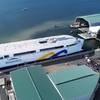Outside of the requirements outlined in OPA 90, there typically aren't many regulations affecting the barge industry. One still-pending piece of legislation is the proposal of undocumented barge numbering.
The Abandoned Barge Act of 1992 added a new chapter and amended another chapter, requiring the numbering of undocumented barges measuring more than 100 gt operating on the navigable waters of the U.S. In enacting the legislation, Congress noted an abandoned barge could become the site for the disposal of hazardous cargoes, wastes and petroleum products, which could lead to water pollution incidents. According to the USCG, numbering these undocumented barges will increase owner accountability, reducing the likelihood barges will be abandoned and used for disposal of oil and hazardous substances.
In 1994, a Notice of Request for Comments formed the basis for the Advance Notice of Proposed Rulemaking (ANPRM), which followed in 1998. All comments responding to the 1994 Notice recommended the USCG, and not individual states, administer a numbering system for undocumented barges. The comments noted several difficulties the states would encounter administering barge numbering programs, including coordination with other states, resource burdens, and enacting state legislation.
Several comments suggested the USCG should use a numbering code similar to the code used for documented vessels, as long as codes differentiate between documented and undocumented barges. Some comments suggested assigning undocumented barges Hull Identification Numbers (HINs).
A few comments indicated it would take a survey of the barge industry to determine the total undocumented barge population and the potential economic impact of any regulations. It can be difficult to identify how many undocumented barges are in operation because many barges are not tracked by government agencies or other organizations.
Based on the comments received, the USCG is considering options for establishing a USCG numbering system administered by the National Vessel Documentation Center (NVDC). Unlike vessel documentation, which serves multiple purposes such as establishing vessel nationality, admitting vessels to restricted trades, and permitting vessels to be the subject of preferred mortgages, the numbering of operating undocumented barges more than 100 gross tons would be used to simply identify their owners.
In its ANPRM, the USCG requested comments on the following questions.
What number should the USCG use for undocumented barges? The USCG believes assigned barge numbers should be similar to the numbers used for documented vessels. There is no plan to include undocumented barges in the HIN system since most existing undocumented barges do not have HINs.
How should owners attach numbers to barges? At this point, the USCG believes numbers should be permanently welded externally to discourage removal and be clearly visible from a distance to help identify barge owners. The USCG does not believe numbers should be marked on the interior as this makes identification difficult.
What information should barge owners provide on barge numbering applications ? The USCG recognizes ? in many cases ? it may be impossible for owners of undocumented barges to prove vessel ownership. The purpose of the proposed barge numbering system is to identify the owners of barges. The USCG does not expect owners of undocumented barges to provide the same information that is required to document a vessel. The Coast Guard plans to propose accepting any available information indicating ownership (such as a bill of sale), or a signed affidavit of ownership.
How many operating undocumented barges measuring more than 100 gross tons are there? Based on available information, the USCG estimates there are approximately 10,000 to 14,000 undocumented barges measuring more than 100 gt and operating on the navigable waters of the U.S.
What are the potential economic impacts of the proposed numbering system? Barge owners would bear the cost of providing needed owner and barge information and costs associated with attaching numbers to the barges. Submitting this information to the USCG should impose only a minimum cost burden.
How will any future regulations affect small entities?
The preliminary regulatory assessment predicted the cost for mandatory numbering of undocumented barges more than 100 gt would not be expected to exceed $100 million. As discussed, preliminary population estimates for the number of undocumented barges measuring more than 100 gt ranges from just under 10,000 to 14,000 barges.
An industry-provided cost estimate for attaching barge numbers ranges from $500 to $1,500 per barge, depending on the method used and whether the work is done in-house or at a shipyard. Assuming a per barge cost of $500 to $1,500 for as many as 14,000 barges, the preliminary cost estimate ranges from $7 to $21 million.
Comments responding to these ANPRM questions essentially stressed the same thing: It's a good idea, but be careful to not create too much of a burden.
Kirby Corp. stated in its comments that it supported the intent of the Abandoned Barge Act of 1992, particularly reducing the likelihood of abandonment of barges along the U.S. waterways, which potentially represent a risk of pollution. However, Kirby stressed the significant consolidation in the inland towing industry has resulted in larger, more responsible companies owning and operating a significant portion of the barges affected by the regulations being developed. Kirby stated it was "highly unlikely any of those owners/operators could ever intentionally abandon any of its barges, particularly if the barge contained pollutants. The effects of adverse publicity and potential for civil and criminal penalties militate strongly against such action."
Kirby's comments also said the USCG should not assign a number or identifier different than the Official Number once assigned to the barge, despite the fact that it may currently be undocumented. That original Official Number appears on the barge's Certificate of Inspection and is the resident identifier for the barge in the Coast Guard's electronic records related to inspection, violations of regulation, user fees, etc. The company did encourage the current practice of the USCG issuing "CG Numbers" to undocumented barges in conjunction with their initial inspection for certification.
Kirby disagreed with the USCG's proposal for external marking requirements, when no such requirements exist for documented barges; barges which may well be nearly identical in construction, route, and service and owned and operated by the same entity.
The company also opposed the establishment of user fees in connection with the regulatory requirements being contemplated.
"We do not believe the contemplated requirements would result in a 'service' to us as vessel owners or add value to our operations. Indeed, the contemplated requirements are aimed at a problem not of our making. In our view, the USCG lacks the justification necessary for the establishment of such fees."
Bunge Corporation, another barge owner, stated, since there were no assurances the system would do anything towards identifying ownership of abandoned barges, let alone assure the barge owner would have the financial ability to pay for removal even if identified; that a numbering system, especially a costly one, would be burdensome, disproportionately expensive, of questionable benefit, and should not be required.
However, the comapny said, if there must be a system, numbering should be similar to the existing system for documented barges, the marking requirements should be identical, and the same number should remain assigned to the barge throughout its life regardless of ownership.
Newport News Shipbuilding recommended the USCG use the letter "U" (for Undocumented) and a five-digit number for undocumented barges, which will provide 100,000 unique numbers for undocumented barges. The numbers should be at least four in. in height and painted in a contrasting color for easy identification. The barge numbers should be positioned on the side of the barge on the port and starboard quarters and forward of the stern of the barge.
The American Waterways Operators (AWO) stated its support of Congress's objective of ensuring abandoned barges do not become safety or pollution hazards on the waterways. The organization is, however, skeptical of the extent to which the establishment of a numbering system for undocumented barges will yield tangible environmental benefits.
"There are other means available to the USCG to identify and trace the ownership of barges that are abandoned, whether intentionally or unintentionally. These include use of the USACE's Waterborne Commerce Statistics database, which can be used to match the characteristics of an abandoned barge with the ownership information contained in the vessel database. We therefore see minimal value-added in the establishment of a numbering system for undocumented barges."
AWO agreed with Kirby's suggestions to allow once-documented barges to retain the Official Number originally assigned to them by the USCG, even if the barge is currently undocumented. AWO also expressed opposition to the assessment of user fees for the initial nurnbering of an undocumented barge, given that the proposed numbering system is a legislative mandate and not a service to the barge owner.
Sponsored Content
Experience Custom Yacht Signs and Designs Tailored to Perfection!

April 2025
 Read the Magazine
Read the Magazine

 Read the Magazine
Read the Magazine
This issue sponsored by:

Modernizing Mariner Credentialing: A Maritime Workforce Imperative
Subscribe for
Maritime Reporter E-News
Maritime Reporter E-News is the maritime industry's largest circulation and most authoritative ENews Service, delivered to your Email five times per week







